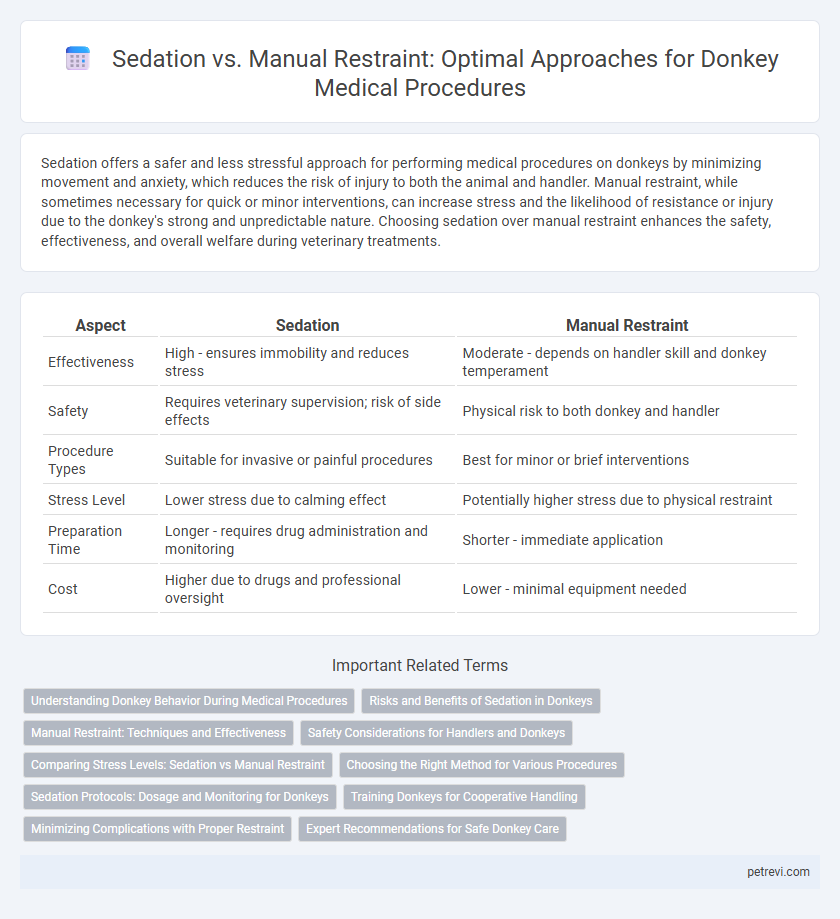Sedation offers a safer and less stressful approach for performing medical procedures on donkeys by minimizing movement and anxiety, which reduces the risk of injury to both the animal and handler. Manual restraint, while sometimes necessary for quick or minor interventions, can increase stress and the likelihood of resistance or injury due to the donkey's strong and unpredictable nature. Choosing sedation over manual restraint enhances the safety, effectiveness, and overall welfare during veterinary treatments.
Table of Comparison
| Aspect | Sedation | Manual Restraint |
|---|---|---|
| Effectiveness | High - ensures immobility and reduces stress | Moderate - depends on handler skill and donkey temperament |
| Safety | Requires veterinary supervision; risk of side effects | Physical risk to both donkey and handler |
| Procedure Types | Suitable for invasive or painful procedures | Best for minor or brief interventions |
| Stress Level | Lower stress due to calming effect | Potentially higher stress due to physical restraint |
| Preparation Time | Longer - requires drug administration and monitoring | Shorter - immediate application |
| Cost | Higher due to drugs and professional oversight | Lower - minimal equipment needed |
Understanding Donkey Behavior During Medical Procedures
Understanding donkey behavior during medical procedures is crucial for selecting the appropriate restraint method, whether sedation or manual restraint. Donkeys often exhibit stress through subtle signs like tension, vocalization, or attempts to withdraw, which can increase the risk of injury during handling. Sedation can facilitate safer and more effective interventions by minimizing movement and anxiety, while manual restraint requires skilled handlers familiar with donkey temperament to prevent distress and ensure procedural success.
Risks and Benefits of Sedation in Donkeys
Sedation in donkeys during medical procedures reduces stress and improves safety by minimizing movement, but it carries risks such as respiratory depression and delayed recovery. Manual restraint avoids drug side effects but can cause physical injury and increased stress for both the animal and handler. Careful assessment of sedation protocols and monitoring is essential to balance the benefits of sedation with its potential adverse effects in donkeys.
Manual Restraint: Techniques and Effectiveness
Manual restraint for donkey medical procedures involves using physical techniques such as halters, ropes, and leg ties to control movement and ensure safety during treatment. Proper positioning and gentle pressure applied to specific points, like the neck and shoulders, enhance effectiveness while minimizing stress and injury risks. Compared to sedation, manual restraint offers immediate control without pharmacological side effects, making it suitable for short or less invasive interventions.
Safety Considerations for Handlers and Donkeys
Sedation during donkey medical procedures enhances safety by minimizing stress and movement, reducing the risk of injury to both handlers and animals. Manual restraint requires skilled handlers to ensure minimal force and maintain calm, but it poses higher risks of accidental harm due to sudden donkey movements. Prioritizing sedation protocols with appropriate dosage and monitoring improves overall safety outcomes in veterinary care for donkeys.
Comparing Stress Levels: Sedation vs Manual Restraint
Sedation significantly reduces stress levels in donkeys during medical procedures by calming their nervous system and minimizing physical resistance. Manual restraint often increases stress indicators such as elevated heart rate and cortisol levels due to physical pressure and limited movement. Studies show sedation enhances procedural safety and animal welfare, making it preferable for handling donkeys in clinical settings.
Choosing the Right Method for Various Procedures
Selecting the appropriate restraint method for donkey medical procedures depends on the procedure's complexity and the animal's behavior. Sedation provides effective muscle relaxation and pain control, ideal for invasive or lengthy interventions, while manual restraint is suitable for simple, quick examinations with minimal stress. Evaluating the donkey's temperament, procedure duration, and required precision ensures optimal safety and efficacy in treatment.
Sedation Protocols: Dosage and Monitoring for Donkeys
Sedation protocols for donkeys typically involve the use of alpha-2 agonists such as xylazine or detomidine, with dosages carefully adjusted between 0.5 to 1.1 mg/kg depending on the procedure and individual animal response. Monitoring vital parameters like heart rate, respiratory rate, and mucous membrane color is crucial throughout sedation to ensure safety and effective sedation depth. Precise dosage and continuous observation minimize stress and complications, providing optimal conditions for medical procedures in donkeys.
Training Donkeys for Cooperative Handling
Training donkeys for cooperative handling significantly reduces the need for sedation during medical procedures, enhancing safety for both the animal and handler. Manual restraint techniques, when combined with consistent positive reinforcement and gradual desensitization, promote trust and compliance in donkeys. Optimizing these training methods increases procedural efficiency, minimizes stress responses, and supports better overall health outcomes in donkeys.
Minimizing Complications with Proper Restraint
Proper restraint during donkey medical procedures significantly reduces stress and the risk of injury, making sedation a crucial option when manual restraint alone is insufficient. Sedation minimizes adverse reactions such as excessive movement or vocalization, thereby preventing complications related to both handling and treatment accuracy. Employing a balanced approach combining minimal sedation and skilled manual restraint optimizes safety and procedural outcomes in donkeys.
Expert Recommendations for Safe Donkey Care
Experts emphasize that sedation improves safety and reduces stress during donkey medical procedures by minimizing movement and pain responses. Manual restraint should be reserved for brief or less invasive treatments to avoid injury and excessive stress. Combining sedation with gentle restraint techniques aligns with best practices for enhancing donkey welfare and ensuring effective care.
Sedation vs Manual restraint for Donkey Medical Procedures Infographic

 petrevi.com
petrevi.com